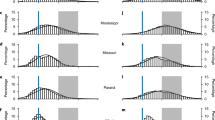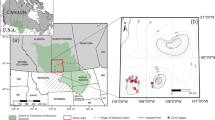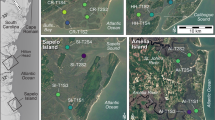Abstract
Dunes with relatively long and parallel crests are classified as linear dunes. On Earth, they form in at least two environmental settings: where winds of bimodal direction blow across loose sand, and also where single-direction winds blow over sediment that is locally stabilized, be it through vegetation, sediment cohesion or topographic shelter from the winds. Linear dunes have also been identified on Titan, where they are thought to form in loose sand. Here we present evidence that in the Qaidam Basin, China, linear dunes are found downwind of transverse dunes owing to higher cohesiveness in the downwind sediments, which contain larger amounts of salt and mud. We also present a compilation of other settings where sediment stabilization has been reported to produce linear dunes. We suggest that in this dune-forming process, loose sediment accumulates on the dunes and is stabilized; the stable dune then functions as a topographic shelter, which induces the deposition of sediments downwind. We conclude that a model in which Titan’s dunes formed similarly in cohesive sediments cannot be ruled out by the existing data.
This is a preview of subscription content, access via your institution
Access options
Subscribe to this journal
Receive 12 print issues and online access
$259.00 per year
only $21.58 per issue
Buy this article
- Purchase on Springer Link
- Instant access to full article PDF
Prices may be subject to local taxes which are calculated during checkout



Similar content being viewed by others
Change history
24 January 2010
In the version of this Article originally published, one of the data points in Fig. 3 was incorrect. This error has been corrected in the HTML and PDF versions of the Article.
References
Bagnold, R. A. The Physics of Blown Sand and Desert Dunes (Methuen, 1941).
McKee, E. D. & Tibbits, G. C. Primary structures of a seif dune and associated deposits in Libya. J. Sedim. Petrol. 34, 5–17 (1964).
Tsoar, H. Dynamic processes acting on a longitudinal (seif) sand dune. Sedimentology 30, 567–578 (1983).
Tsoar, H. Linear dunes—forms and formation. Prog. Phys. Geogr. 13, 507–528 (1989).
Rubin, D. M. & Hunter, R. E. Bedform alignment in directionally varying flow. Science 237, 276–278 (1987).
Rubin, D. M. & Ikeda, H. Flume experiments on the alignment of transverse, oblique, and longitudinal dunes in directionally varying flows. Sedimentology 37, 673–684 (1990).
Lacy, J. R., Rubin, D. M., Ikeda, H., Mokudai, K. & Hanes, D. M. Bed forms created by simulated waves and currents in a large flume. J. Geophys. Res. 112, C10018 (2007).
Werner, B. T. & Kocurek, G. Bed-form dynamics; does the tail wag the dog? Geology 25, 771–774 (1997).
Kocurek, G. & Ewing, R. Aeolian dune field self-organization—implications for the formation of simple versus complex dune-field patterns. Geomorphology 72, 94–105 (2005).
Reffet, E., Courrech du Pont, S., Hersen, P., Douady, S. & Fulchignoni, M. in Planetary Dunes Workshop, abstr. 7018 (2008); <http://www.lpi.usra.edu/meetings/dunes2008/pdf/7018.pdf>.
Fryberger, S. G. & Dean, G. in A Study of Global Sand Seas (ed. McKee, E. D.) 137–169 (USGS Professional Paper 1052, GPO, 1979).
Rubin, D. M. & Hunter, R. E. Why longitudinal dunes are rarely recognized in the geologic record. Sedimentology 32, 147–157 (1985).
Rubin, D. M. Cross-Bedding, Bedforms, and Paleocurrents (SEPM, 1987).
Bristow, C. S., Duller, G. A. T. & Lancaster, N. Age and dynamics of linear dunes in the Namib Desert. Geology 35, 555–558 (2007).
Rubin, D. M., Tsoar, H. & Blumberg, D. G. A second look at western Sinai seif dunes and their lateral migration. Geomorphology 93, 335–342 (2008).
Hesp, P. A. The formation of shadow dunes. J. Sedim. Petrol. 51, 101–111 (1981).
Herrmann, H.,J., Durán, O., Parteli, E. J. R. & Schatz, V. Vegetation and induration as sand dunes stabilizers. J. Coast. Res. 24, 1357–1368 (2008).
Hesp, P. A., Hyde, R., Hesp, V. J. & Qian, Z. Longitudinal dunes can move sideways. Earth Surf. Process. Landf. 14, 447–451 (1989).
Petrov, M. P. Deserts of the World (Wiley, 1976).
Melton, F. A. A tentative classification of sand dunes: Its application to dune history in the southern High Plains. J. Geol. 48, 113–174 (1940).
Verstappen, H. T. On the origin of longitudinal (seif) dunes. Z. Geomorphol. 12, 200–220 (1968).
Tsoar, H. & Moller, J. T. in Aeolian Geomorphology (ed. Nickling, W. G.) 75–95 (Allen and Unwin, 1986).
Kerr, R. C. & Nigra, J. O. Eolian sand control. Bull. Am. Assoc. Petrol. Geol. 36, 1541–1573 (1952).
Schatz, V., Tsoar, H., Edgett, K. S., Parteli, E. J. R. & Herrmann, H. J. Evidence for indurated sand dunes in the Martian north polar region. J. Geophys. Res. 111, E04006 (2006).
Flood, R. D. Classification of sedimentary furrows and a model for furrow initiation and evolution. Geol. Soc. Am. Bull. 94, 630–639 (1983).
Bryant, W., Bean, D., Slowey, N., Dellapenna, E. & Scott, E. Deepwater currents form mega-furrows near US Gulf ’s Sigsbee Escarpment. Offshore Magazine 61, 94–95 (2001).
Radebaugh, J. et al. Dunes on Titan observed by Cassini RADAR. Icarus 194, 690–703 (2008).
Tokano, T. Dune-forming winds on Titan and the influence of topography. Icarus 194, 243–262 (2008).
Lorenz, R. D. et al. The sand seas of Titan: Cassini RADAR observations of longitudinal dunes. Science 312, 724–727 (2006).
Barnes, J. W. et al. Spectroscopy, morphometry, and photoclinometry of Titan’s dunefields from Cassini/VIMS. Icarus 195, 400–414 (2008).
Spencer, C. et al. Terrestrial and Martian analogues to the sand seas on Titan. Geol. Soc. Am. Abstr. Prog. 39, 571 (2007).
Reffet, E. et al. Titan’s longitudinal dunes in the lab. Bull. Am. Astron. Soc. 39, 501 (2007).
Stiles, B. W. et al. Determining Titan surface topography from Cassini SAR data. Icarus 186 10.1016/j.icarus.2009.03.032 (2009).
Wald, C. Titan’s winds seem to blow backward. Science 323, 1418 (2009).
Lancaster, N. et al. Late Pleistocene and Holocene dune activity and wind regimes in the western Sahara of Mauritania. Geology 30, 991–994 (2002).
Rubin, D. M. Lateral migration of linear dunes in the Strzelecki Desert, Australia. Earth Surf. Process. Landf. 15, 1–14 (1990).
Soderblom, L. A. et al. Correlations between Cassini VIMS Spectra and RADAR SAR images: Implications for Titan’s surface composition and the character of the Huygens probe landing site. Planet. Space Sci. 55, 2025–2036 (2007).
Lunine, J. L. & Lorenz, R. D. Rivers, lakes, dunes and rain: Crustal processes in Titan’s methane cycle. Annu. Rev. Earth Planet. Sci. 37, 299–320 (2009).
Tokano, T. et al. Methane drizzle on Titan. Nature 442, 432–435 (2006).
Ádámkovics, M. et al. Widespread morning drizzle on Titan. Science 318, 962–965 (2007).
Zarnecki, J. C. et al. A soft solid surface on Titan as revealed by the Huygens surface science package. Nature 438, 792–795 (2005).
Radebaugh, J. et al. Linear dunes on Titan and earth: Initial remote sensing comparisons. Geomorphology 10.1016/j.geomorph.2009.02.022 (2009).
Acknowledgements
We thank A. Draut, J. Xu, and J. Warrick (all at USGS, Santa Cruz), J. Barnes (University of Idaho), and J. Radebaugh (Brigham Young University) for reviewing this manuscript and offering constructive comments. We also thank the Australian Academy of Science and the Chinese Academy of Science for funding and support, G. M. da Silva for analytical assistance, and M. L. Eggart for cartographic assistance.
Author information
Authors and Affiliations
Contributions
P.A.H. arranged travel to Qaidam Basin, and the authors conducted fieldwork there together. P.A.H. analysed dune sediment for salt and mud content and calculated the sand transport rose. D.M.R. wrote the manuscript, and P.A.H. reviewed it and added content.
Corresponding author
Rights and permissions
About this article
Cite this article
Rubin, D., Hesp, P. Multiple origins of linear dunes on Earth and Titan. Nature Geosci 2, 653–658 (2009). https://doi.org/10.1038/ngeo610
Received:
Accepted:
Published:
Issue Date:
DOI: https://doi.org/10.1038/ngeo610
This article is cited by
-
Contribution of underlying terrain to sand dunes: evidence from the Qaidam Basin, Northwest China
Journal of Arid Land (2021)
-
Influence of salinity and moisture on the threshold shear velocity of saline sand in the Qarhan Desert, Qaidam Basin of China: A wind tunnel experiment
Journal of Arid Land (2019)
-
Titan as Revealed by the Cassini Radar
Space Science Reviews (2019)
-
Electrification of sand on Titan and its influence on sediment transport
Nature Geoscience (2017)
-
Pattern analysis of a linear dune field on the northern margin of Qarhan Salt Lake, northwestern China
Journal of Arid Land (2016)



